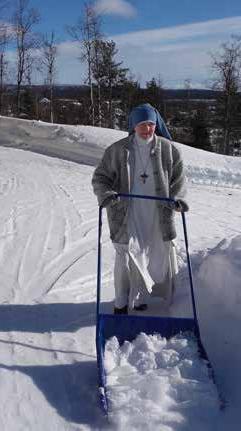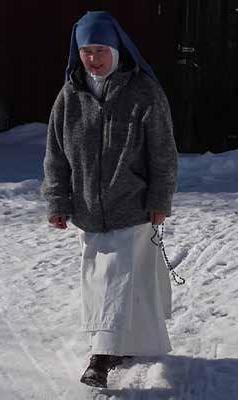
7 minute read
Would you believe it?
Alberto Carosa reports on how heroic nuns are at the helm of the first outpost of traditionalism in northern Sweden
Some time ago, I reported on what I presumed was the world’s northernmost Latin Mass - the Extraordinary Form celebrated in Jyväskylä, a major city in the north of Finland (see Mass of Ages, issue 195, Spring 2018).
But now I have to eat humble pie since I have realized the above information was not entirely correct. It is still true that the Old Rite Mass in Jyväskylä remains the northern-most Mass celebrated on a regular weekly basis, but the EF is sporadically being celebrated even further north, in Swedish Lapland, well beyond the Polar circle.
Mutatis mutandis, this incredible story reminds us of the ancient Desert Fathers (along with Desert Mothers), who were early Christian hermits, ascetics, and monks living mainly in the Scetes desert of Egypt around the third century AD. The desert monastic communities that grew out of these informal gathering of hermit monks became the model for Christian monasticism.
Something resembling this can be found in the female monasteries more recently established in North America. They were built “in the extreme hardship of a dry and unforgiving rocky terrain on an arid mountaintop in Southwest New Mexico”, as was the case for the five foundresses of St Joseph Monastery. Even more explicit were the Poor Clares of Perpetual Adoration (PCPA) of Our Lady of Solitude Monastery in Tonopah, Nevada, more simply called “desert nuns”, as shown by the very name of their portal, desertnuns.com.
But other than the brown desert of sand and stones, there is another desert with no less hardship and extreme weather: the white desert of ice, snow and cold in the northern hemisphere. And it’s here, in the tiny village of Lannavaara, in Swedish Lapland in Northern Sweden, 250km beyond the Polar Artic Circle, that a new religious order is taking shape based at Sankt Josefs Kloster (Monastery of St Joseph): the Congregation of the religious of Marias Lamm (Mary's Lambs). 14

Sankt Josefs Kloster in winter
As recounted by the Swedish Sister Amada Mobergh to Italian Catholic news agency SIR in October 2015, this “adventure” started in 2013, when together with Sister Karla the two decided to settle there to pray, in the silence of this “barren land”. When Sister Amada converted in London, she was in her twenties. She also found her religious vocation and spent the following 30 years in India, former Yugoslavia, Kosovo, Italy, Albania, Iceland and in the United Kingdom, in the congregation of the Missionaries of Charity. After realizing that her desire for a more contemplative life was the will God, she was given permission by the Bishop of Stockholm, Cardinal Anders Arborelius, to return to Sweden to start her new life. It was made clear that the Catholic Swedish Church is small and poor, so financial support would not be available.
After visiting four monasteries in Southern Sweden, following a series of coincidences, Sister Amada received a phone-call from the north: a house was available for rent. The Sisters gave her the money for the train trip and she immediately left for the north. The house turned out to be unsuitable, but the miracle coincidences continued and Sister Amada and Sister Karla managed to find temporary free accommodation. “We arrived on December 24, 2011; the temperature was minus 30 degrees C. I immediately understood that this is where I had to be”, said Sister Amada.
After 18 months the Sisters had to move. The house was too small to accommodate all those who had come to visit, and to pray.
They found the old school of Lannavaara, “surrounded by wilderness”. It had been unused for years and was expensive for them, since they had no more money. But the miracles continued. “We moved there even though we lacked the money to buy it”, said Sister Amada. And that first winter there was no proper heating.
“We worked day and night to make it habitable. One day a man from Norway passed by, enthusiastic about our experience. He had never heard of a monastery in the far north”, she said. He wanted to help as he thought it was important and good for the Church, and for souls, to have a Monastery in such a remote place. After all, Lapland accounts for roughly one fourth of Sweden and there has never been a stable Catholic presence so far in the north, perhaps not even before the Reformation. Their Norwegian visitor bought the school for them, just a few days before their agreement was about to expire!
“Every day God helps us to go on with His Providence. His daily miracles enable us to go on with great gratitude and joy”, and with a daily life marked by “silence, solitude and prayer”.
“My suffering is to see there is no awareness of the sacraments in Sweden, and especially in this part of the country”, Sister Amada went on. “There is spiritual poverty, distance from God and from the Church”. This is the meaning of life here in the newly-established monastery of Saint Joseph: “to pray and to offer one’s life to God following the example of Mary for the conversion of souls, especially of Scandinavians and for the rebuilding and restoring of the Church and Catholic Culture”.
Darkness in this part of the world lasts almost seven months of the year but for the Sisters this helps “the prayer of all those who live darkness within themselves, to find the light of Jesus”.

Sister Amada clears a path through the snow
The nuns have a good relationship with the local people in the village, who help them with all kinds of practical problems regarding the house.
Groups come to hear about their life and faith; a few stay, to share in silence and prayer.
After having obtained diocesan recognition as “consociationibus dioecesanis” of the Lambs of Mary the Sisters hope to be able to demolish the old school and build a simple but traditional monastery, including a Chapel dedicated to the Immaculate Heart of Mary and Queen of the Nordic countries.
It would be another miracle of Divine Providence to be able to build the new monastery but the Sisters are confident.
In the beginning they traveled to the nearest parish church in Luleå, some 400 kms south. During winter the journey takes more than five hours; even in summer it takes four hours. “It’s very dark during the winter, the roads are covered with ice and snow; reindeer and other wild animals cross the streets” Sister Amada said. “It’s risky, but we got used to it. All you need is to pray and go on”. The Sisters at least had priests from the parish who came to celebrate the Holy Mass for them and to hear confessions. Priests also came from all over the country to make their solitary retreats here.
“We had an English priest with us for a longer time – five years – with some intervals: that was a great blessing”, the Sister said.
Another priest has rented a house in the village and is trying to learn to live an eremitic life. He is keen to stay and has even learned fluent Swedish.
But the “miracle of miracles” will materialize next May 8, if all goes according to plan, when a Benedictine monk will settle with the Sisters, at least for a year.
In fact, when we met in 2017 on the occasion of the yearly Summorum Pontificum pilgrimage of traditional-minded faithful to Rome, Sister Amada spoke to me about the major problem of not being able to rely on the daily celebration of the traditional Latin liturgy.
“But now we will be soon supported by a young priest”, she told me recently, “who, like us, wants to live a contemplative eremitic life, praying the Latin Divine Office, saying the Latin Mass and praying and offering his life for the Church and the salvation of souls, which is our very Charism!”

Sister Karla praying the Rosary
Sister Amada had asked one of the priests who occasionally came to visit them if he could celebrate the Ancient Roman Latin rite during his stay in the monastery. He happily acceded to her request. So, the first old rite Mass was celebrated in December 2016. “After that occasion we have had two other priests who, in a deeper way, led us into the celebration of the old rite, since they themselves loved it!” recalls Sister Amada. “We even had a visit by a priest from Ecclesia Dei, who celebrated Mass here.”
“We also felt very much at home with it and loved it!”, she went on, “It was majestic, silent, the sense of mystery was very present and even though both my fellow Sister and I are new to the Latin language and that way of celebrating the Holy Mass, we felt very soon called to implement it into the Liturgy of the Lambs of Mary.”
How remarkable that in the face of an increasingly secularized world we have the first traditional nuns in Scandinavia, fully backed by their bishop, based in the white desert of the polar circle? Here the Old Rite liturgy is celebrated for the first time in centuries thanks to these heroic nuns.
To contact and support the nuns visit, www.mariaslamm.se










